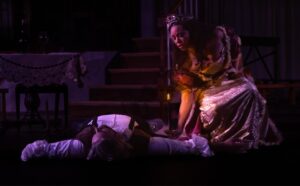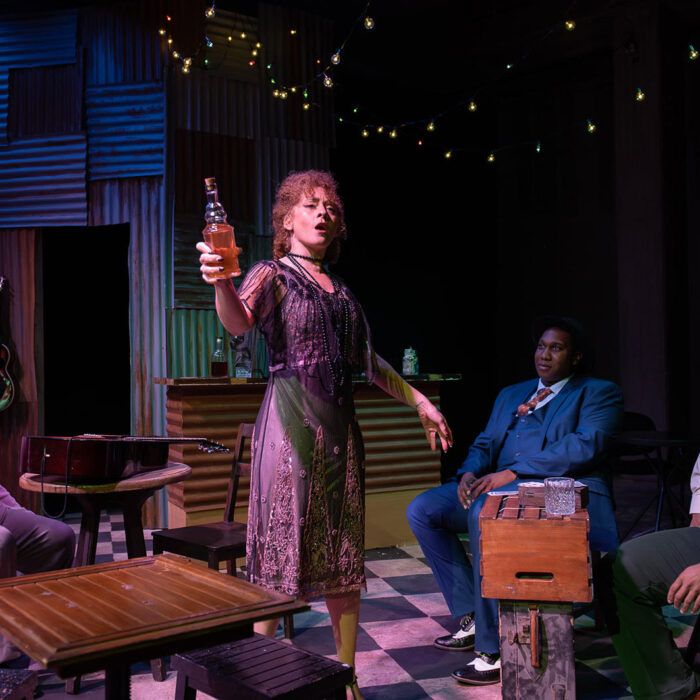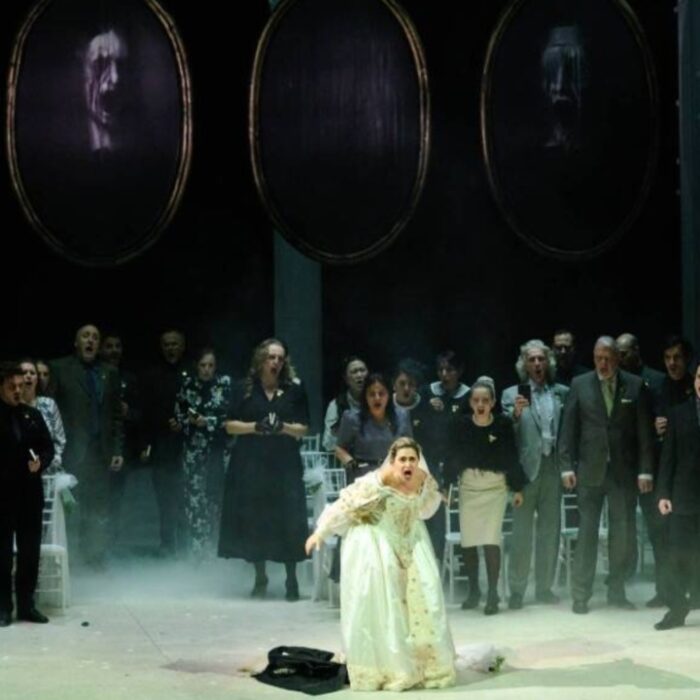
(Photo credit Madeline Grey)
Lacking public monies common in Europe, opera becomes ever harder to produce in the USA, but its enthusiasts are a determined lot. The Old Line State used to enjoy a typical American setup for presenting opera, an established twentieth-century organization, the Baltimore Opera Company, situated in a sizable venue in Maryland’s largest city, the Lyric Opera House near downtown Baltimore. The leadership of American überdiva and Maryland resident, soprano Rosa Ponselle (1897-1981) established the company’s high quality in the 1960s and 1970s. I still cherish memories of a 2002 “Rigoletto” starring Mark Delavan there, in the auditorium modeled on Amsterdam’s legendary Concertgebouw.
The late 2000s recession felled Baltimore Opera Company, which closed abruptly in 2008. The company phoenixed briefly as Lyric Opera Baltimore but breathed its death rattle in 2017. (For an overview of opera’s history in Baltimore, see Laura Farmer’s 2023 piece in Baltimore Magazine). Filling this void we find two newer companies, right-sized to face the fiscal hurricane assailing the arts in America. It makes sense; other American cities such as Baltimore’s Midwestern sister, Saint Louis, support plural, leaner houses instead of one larger grand opera company. Opera Baltimore, with the word ‘concert’ now resected from its name, presents in multiple venues including the cozy Engineers’ Club in the Mount Vernon neighborhood, recently celebrating their fifteenth anniversary with a February gala. And Maryland Opera (MO) opened in 2019, run by James Harp, a veteran of the old Baltimore Opera Company and Lyric Opera Baltimore. Too, don’t confuse MO with Maryland Lyric Opera, based in College Park, which presented a lot of hefty repertory before shuttering in 2023. MO began modestly, with concerts of scenes and arias for several seasons, before moving to full staging. Well-known for his enthusiasm for Puccini, Harp chose the main standard repertory work in which the title character is herself an opera singer, “Tosca,” and directed the show himself.
Un tal baccano in chiesa!
For Puccini’s zesty Roman candle, Maryland Opera selected the Episcopal Church of the Redeemer as the venue, in a swank neighborhood on Baltimore’s north side. This sanctuary boasts one peculiar feature that lends it well to a theatrical performance: expansive transepts, so wide that they rival the nave’s area. Indeed, rather than a truly cruciform layout, the nave and transepts nearly form a capital T, with no apse. Thus, the altar housed the stage, with the orchestra installed to the stage’s left, and “backstage” also located in the transept, to the stage’s right. Though a work that half the audience knows word-for-word, this “Tosca” benefitted from a supertitle screen above the church’s choir. Where would we be without the audience tittering at Tosca’s instruction that Cavaradossi make his Magdalene dark-eyed rather than blue-eyed? It pays to have a real pipe organ for the Te Deum, and despite the small chorus, if there’s one thing Episcopalians know how to rock, it’s a procession.
A suitable arrangement. How to succeed? Cast it well. And with “Tosca,” you’ve got options. The title role we usually slot as lirico-spinto, but full lyrics have sung it, as have dramatic sopranos. Some coloraturas even, who will never sing the role complete, still toss the audience “Vissi d’arte” in recital. Women of different repertory and linguistic backgrounds have sung the role; if you want to start an argument among Puccini fans of a certain age, bring up Hildegard Behrens’ interpretation of the role. Tosca’s attraction to a wide range of vocalists seems like an obvious fact rather than a challenge to the gods of fach. So representative of opera itself is Tosca that her showcase aria bled into American popular culture without Chuck Jones’ and the Warner Brothers’ assistance—as I write, a Samsung Galaxy S24 cellphone commercial featuring Maria Callas just aired on ESPN, La Divina posing the question “perché me rimuneri cosi?”
Callas, who led the mid-century bel canto revival, and whose Tosca opera fans regard as one of the greatest portrayals of any role by anyone, her white hot EMI Angel studio take with Victor De Sabata a core occupant of the record shelf. Opera talkers frequently cite the long tail of bel canto in middle and even late Verdi, or Wagner’s fondness for Bellini. You hear less of this talk by the time the calendar turns to the fin-de-siècle verismo composers, Puccini and contemporaries, but in some ways, Puccini officiates a marriage of verismo’s dialogic naturalism with bel canto’s purity of vocal line. What if. What if you momentarily put fach aside, and you cast Tosca prizing, above all else, beautiful singing?
Sei troppo bella, Tosca
Maryland Opera scored a casting coup for their mainstage celebration, the role debut of soprano Christine Lyons as Floria Tosca. If you’re unfamiliar with this singer, get familiar, soon. Your reviewer first encountered her in Bellini’s “Norma,” in the late 2010s at Winter Opera Saint Louis, then well-reviewed by the witheringly exacting critic Sarah Bryan Miller. While a company that performs in a huge space, like the Metropolitan or San Francisco Opera, probably would cast a larger voice for the Druid priestess, Lyons dazzled in the thousand-seat Skip Viragh Center, vocally equal to this killer role, and dramatically effective too, not least in Act two’s opening where Norma considers but thinks better of going Medea on her children, to the cello’s haunting accompaniment. Lyons returned to the Gateway City last year for Norina in Donizetti’s “Don Pasquale,” more in her natural fach’s lane. Every so often a soprano comes along with a sound so beautiful that when you hear them you think “I gotta sit down” before remembering that your glutes rest on a seat already. In recent decades, Ruth Ann Swenson and Janai Brugger are two. It’s easy to fancy Bellini’s ghost sent Lyons to us. She combines purity of line with agilitá, and possesses seamlessly connected registers, a sunny top, a warm middle, and surprisingly vibrant chest. And when she sings a role that’s a bit “too big” for her voice, she doesn’t push; she sings it with her own voice.
Lyons’ musical and theatrical intelligence served her well in Baltimore. Her bell-like “Mario, Mario, Mario” from the transept toned sweetly, as she appeared in a pastel gown with a short green train and black boots. After two perplexed but distinct deliveries of “lo dici male,” she gave a nuanced read of the “Non la sospiri la nostra casetta” passage, rendering its close “ah piovette voluttà, volte stellate,” like fluid caressing the container into which it flows. Tosca often broadcasts rage on regarding Marchesa Attavanti’s portrait—that Betty/Veronica dynamic with women’s hair color runs deep—but Lyons communicated anxiety more than rage at the idea of Cavaradossi fancying the Petrarchan aristocrat. This transmuted to genuine hurt when repeating Attavanti’s name upon Scarpia’s deception with the abandoned fan. Lyons can do twenty different things with her incandescent eyes, and when Scarpia touched her shoulder we saw barely contained revulsion, fear, and the very slightest thrill, all at once.
Sale, ascende l’uman cantico
In Act two, Lyons’ vocal entrance soared, offstage in the transept, augmented by the church’s acoustics—complaining about ecclesiastical acoustics is a commonplace in classical music reviews, but the Church of the Redeemer hosts music unusually well, lacking overlong reverberation times. Adorned with a champagne and raspberry tiara and a shiny, frilly gown, she imbued “Mario, consenti ch’io parli” with a blood red, verismo color. Act two’s staging forms an extended slow dance between Tosca and Scarpia, and Lyons stepped prudently in pushing aside his generously poured stemware. She didn’t appear to notice Chekhov’s fatal blade on the desk, more of a chef’s knife than a letter opener or paring knife, until she needed it.
Her showstopper, “Vissi d’arte,” came rich with detail. One of the best happenings in classical voice, when a singer makes piano soft, but it paradoxically feels loud. Mezzo-soprano Dolora Zajick was the world champ at that. Lyons began the aria nearly pianissimo, and then shaped a plaintive arc with “quante miserie conobbi aiutati.” She gave an earnest color with “con fe sincera” and a heartbreaking diminuendo on “diedi fiori agli altar,” as though these altar flowers had since wilted. Then suddenly, “perchè me ne rimuneri così” followed with an abrupt facial change and timbral alteration, giving the sense of spontaneity in Tosca’s plea to God—the setup had been meditation on the good works Catholic doctrine obligates her to do, not a preloaded laundry list of justifications why Scarpia’s assault shouldn’t occur—which should have been a given. “Che ne ridean più belli” unfurled radiantly, and the high A addressing the Lord, “perchè, perchè Signor” seemed to float clear out of the church. After the audience responded in full voice, she looked to the vaulted ceiling, giving the impression that “ecco, vedi” was directed as much to God as to Scarpia. She finally sipped the previously rejected wine as Scarpia signed the safe passage letter, and only then visibly spied the knife, communicating a dissociative shock as she stabbed him, and giving him a last thrust to finish with the final “muori!” Wearying is the widespread audience habit of laughing when Tosca pardons the dead Scarpia—Act one contains all the jokes in “Tosca.” Lyons hit us with one more lovely alveolar trill with “tremava,” and could not regard the corpse as she dropped, not placed, the cross on his chest. Knockout thee-ater by the composer and the soprano alike.
Tosca the diva somehow manages a wardrobe change between the Farnese Palace and the Castel Sant’Angelo, Lyons now in more pastels with a sweetheart neckline. As in the first two acts, she peppered the final duet and the dénouement with appealing details, too many too recount, especially a weightless float in “a sol cadente, nuvole leggere” referencing the clouds dispersing at sunset, as Tosca and Cavaradossi aim to do. Her bel canto vocalism remained to the very last high B♭ before departing the parapet.
E avanti a lui tremava tutta Baltimore
Strongest among the men—as in Verdi’s “Rigoletto” and “La Traviata,” the baritone ranks the tenor in importance to the work—Andrew Manea struck the appropriate balance between elegant orderliness freak and gross aggressor. He leaned into Scarpia’s few moments of lesser villainy, with a softer and convincing tone at “darei la vita per asciugar quel pianto.” Performance practice surrounding “Tosca” simply will not transfer from the last century to the #metoo era, and that rape-culturish business about Tosca being more attracted to Scarpia than Cavaradossi, once de rigueur, won’t do and never should’ve. Yet, the mythic scope of the story demands a tension between them past mere contempt, and lust on his part; they’re worthy adversaries, and she knows she’s met her match in that department—running Cavaradossi is much easier. Manea proved a worthy foe dramatically, and vocally sometimes. He pushed quite a bit, and “Va, Tosca” sounded shouty despite the lean orchestral forces beneath, all force and little suavity. This didn’t prevent the audience from losing their minds with approval at the Act one curtain. Manea towered menacingly over the quite-petite Lyons, dressed in elegant blacks and reds. He saved his best vocalism for “Già mia dicon venal” in Act II, with a burnished legato vaguely reminiscent of Greer Grimsley. He also did a better job than most baritones of seeming inert after his stabbing.
Il Cavalier Cavaradossi
As happens at many companies these days, Maryland Opera’s fortune ran out with the tenor. Dominic Armstrong acted the part skillfully but pushed his voice into dire straits. One wonders about the effects of his appearance at Carnegie Hall last month in Schönberg’s epic swansong for extremely late Romanticism, “Gurre-lieder.” In attendance then, your reviewer was dismayed by Maestro Leon Botstein’s recklessly steamrolling the vocalists with a punishing sextuple-forte orchestra, when Schönberg’s mammoth orchestration instead requires quite the opposite, careful calibration. Armstrong’s instrument probably ranks a tad small for that work anyway, and even Cavaradossi’s lirico-spinto heft proved challenging this night. From “Recondita armonia” on, visible jaw tension was on display. He shaped some phrases nicely, like “Tosca ha l‘occhio nero.” But his forceful attacks on notes middle and high marred the long love duet. Lyons’ superior vocal production gave the illusion of a bigger voice than his in their duets. In the first, his support dropped out entirely with “mia sirena,” although he rallied some in the “qual occhio al mondo” passage. At lower volume, he fared better, but at mezzoforte he blasted somewhere closer to fortissimo, and the voiced throbbed in a piston-like tremolo.
His offstage torture scene carried well, and he emerged believably bloodied, but his big moment in Act two combined a “sei tu” with a weird, nearly ingressive sound with a wild, shaky “Vittoria, vittoria.” In Act three, “E lucevan le stelle,” conformed to the established pattern, his evening contained in miniature. Affecting in the nearly parlando start of the aria, things deteriorated with “discogliea,” with percussive attacks on notes. He acted the character well, broadcasting to the audience his white lies protecting Tosca’s feelings, and he passed Cavaradossi’s meta-theatric death with flying colors. In “Puccini Without Excuses” (2005), William Berger reported that he didn’t know if Plácido Domingo first acted the mock-but-real execution by indicating Cavaradossi knew that Scarpia would double-cross him and he would die, but Domingo was the first Berger saw do it that way. Armstong went this direction, and it adds a lot to the opera’s dénouement. After being worked over by both Leon Botstein and the Roman police within three weeks’ time, Armstrong might benefit from a Lieder recital preceded by a recuperative vacation.
Maryland, My Maryland
The men singing the comprimario roles performed competently if unspectacularly. Jarrod Lee, who appeared as a late-arriving jump-in, leveraged the Sacristan’s humorous exchanges with Cavaradossi. Kevin Paton-Cole worked two shifts as Angelotti in Act one and the Jailer in Act three, with a sizable bass of pine bark color. His haggard look in Act one presented him as though Angelotti already served some time hiding in Cavaradossi’s well, and his Jailer gave the painter a nonplussed, “who has time for that” assent to delivering the farewell letter to Tosca in Act three. Tenor Samual Keeler as Spoletta, and bass Phillip Collister-Murray as Sciarrone both combined the appropriate fear of Scarpia with malice towards everyone else.
Harp’s straightforward staging worked well—Tosca doesn’t really demand a concept, since the mythic collision between the protagonist and antagonist constitute story enough. The costumes borrowed from Tri-Cities Opera underlined the two most important characters, Tosca and Scarpia, smocking Cavaradossi and outfitting the rest as you’d expect. Fun details abounded. Scarpia actually shoved a nun aside in Sant’Andrea della Valle, and Spoleta’s stagily-executed Jesuit prayer drew attention again to the venue—if somebody has to stand in for Roman Catholics, who better than Episcopalians? Scairrone confiscated a cross from the priest and threw it at the dead Cavaradossi. Lyons’ valedictory jump looked believable enough. The only false note in the staging was Cavaradossi’s jumbo Attavanti portrait, a blonde woman of 1970s vintage, eyes unhinged and flaunting a parted rictus with sexy intent, looking less like the Magdalene and more as though she’d barely escaped Heaven’s Gate. More felicitously, the company permitted Lyons to do her own makeup, and hair, in lovely twists. Black opera singers recount oodles of screwups committed by white colleagues where cosmetics and wigs are concerned.
Maestro Steven White’s orchestra pushed the boundary of how far you can successfully reduce a score, rostering just thirteen musicians including the organist, with a single instrument doubled, a first and second violin. “Tosca” is one of the cello-est operas in the repertory, and Kristen Walsh stood out. Harp himself did the honors on piano, inviting comparison to Joy Schrier with Baltimore Opera in their concert mode, who performs miracles like giving the audience an entire “Adriana Lecouvreur” on a single Steinway. Half a dozen more string players would beef up the band. Percussionist Barry Dove proved crucial in this lean staffing.
A generally successful “Tosca,” headlined by Ms Lyons’ gorgeous bel canto vocal stylings. If they bring realistic expectations about scope, audiences will deem Maryland Opera a worthy complement to Opera Baltimore. Subprime mortgage-backed derivatives may crash the global economy and sink a fine arts nonprofit or two, but you can’t kill opera in Charm City.



